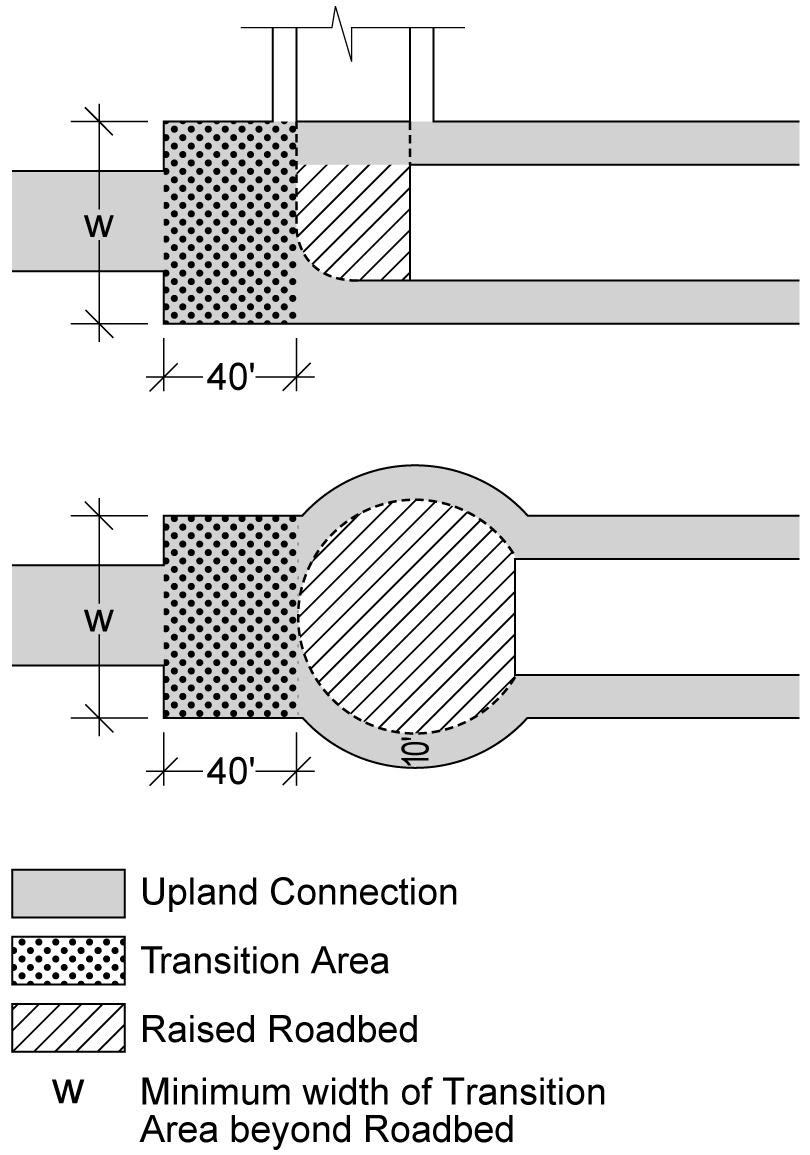Design Requirements for Upland Connections
Upland connections shall be improved in accordance with the provisions of this Section.
(a) Circulation and access
(1) For Type 1 upland connections provided in accordance with the provisions of paragraph (a) of Section 62-561, there shall be at least one circulation path linking an open street, public park or other public place with a shore public walkway. Such path shall have a minimum clear width of 12 feet. Any secondary paths shall have a minimum clear width of six feet.
(2) For Type 2 upland connections provided in accordance with the provisions of paragraph (b) of Section 62-561, each pedestrian walkway shall have a circulation path with a minimum clear width of eight feet linking an open street, public park or other public place with a shore public walkway. However, when a turnaround is provided, the entire required area shall be provided as a circulation path.
(3) For transition areas, a circulation path with a width of at least 12 feet shall connect each circulation path of the Type 2 upland connection with a circulation path of a shore public walkway, supplemental public access area or Type 1 upland connection, whichever is applicable.
(b) Paving
(1) For Type 1 upland connections, at least 40 percent but not more than 65 percent of the entry area shall be paved. Such paving shall include a five foot wide area along at least 70 percent of the frontage adjoining a public sidewalk.
(2) Where any upland connection is interrupted by a private driveway, the full width of the required upland connection shall traverse the roadbed without a drop in level, and be paved with materials distinct from the roadbed. Such portion of the upland connection shall not count towards fulfilling a minimum required amount of waterfront public access area.
In addition, for Type 2 upland connections, the area of the roadbed between both circulation paths, within which lines perpendicular to the upland connection traversing the roadbed can be drawn or the portion of the roadbed within a vehicular turnaround, shall be raised to be flush with the level of such adjoining upland connections.
Type 2 Upland Connection
(62—64)
(3) The roadbed paving material of a private driveway leading to a vehicular turnaround may be extended into the turnaround provided the area of the turnaround paved with such material is not wider than the roadbed leading to the turnaround. The remaining portions of the turnaround shall be paved with distinct materials to facilitate pedestrian usage. In addition, the level of the area within the turnaround shall be raised to be flush with the level of adjoining circulation paths.
(c) Planting
(1) For Type 1 upland connections, at least 40 percent of the area of the upland connection shall be planted in accordance with the provisions set forth in Section 62-655 (Planting and trees).
In addition, the following rules shall apply:
(i) where such upland connections do not abut open parking lots or private driveways, six caliper inches of ornamental trees or their equivalent in multi-stemmed plants shall be required for every 100 linear feet of upland connection.
(ii) where such upland connections abut an open parking lot, screening shall be provided within the upland connection along the curb of such parking lot in accordance with Section 37-921 (Perimeter landscaping).
(iii) where such upland connections abut a private driveway, a continuous tree pit shall be provided within the upland connection along the curb of the driveway. Such tree pit shall meet the minimum planting requirements set forth in Section 62-655, and in addition, shall be planted with one tree for every 25 feet of private driveway frontage.
(iv) where such upland connections do not coincide with a visual corridor, at least 30 percent of the required open area along the length of the upland connection shall be planted, and the requirements of Section 62-513 (Permitted obstructions in visual corridors) shall apply within such open areas.
(2) For Type 2 upland connections, a continuous tree pit shall be provided within the upland connection along the curb of the private driveway. Such tree pit shall meet the minimum planting requirements set forth in Section 62-655, and in addition, shall be planted with one tree for every 25 feet of private driveway frontage. Portions of the continuous tree pit may be paved with permeable paving such as Belgian block or similar unit pavers in order to accommodate any required amenities, such as benches or bicycle racks, or other permitted obstructions in accordance with the provisions of Section 62-611. However, no continuous tree pit shall be required where an upland connection abuts a portion of a roadbed that is required to be raised pursuant to paragraphs (b)(2) or (b)(3) of this Section.
(3) For transition areas, at least 40 percent of such area shall be planted. In addition, a minimum of two canopy trees or their equivalent in caliper inches of ornamental trees or multi-stemmed plants are required.
(d) Seating
At least 12 linear feet of seating shall be provided for every 100 linear feet of upland connection, excluding the length of any entry or transition areas and the first 50 feet of a Type 2 upland connection. Such excluded areas shall have at least 24 linear feet of seating.
(e) Trash receptacles
One trash receptacle shall be provided within 15 feet of a street, public park or other public place and one receptacle shall be provided where the upland connection adjoins a shore public walkway or supplemental public access area, pursuant to Section 62-658.


